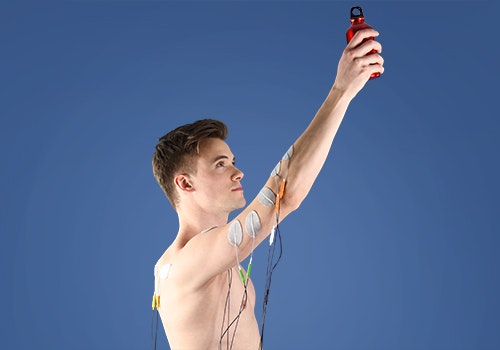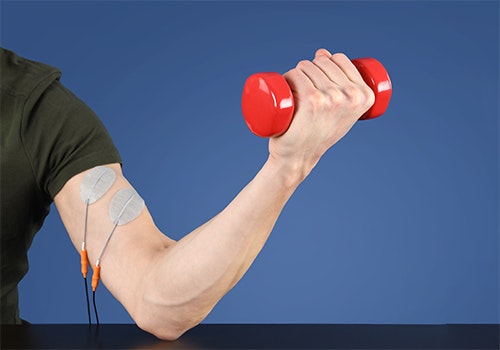Muscular imbalance
Muscular imbalance is an imbalance between two muscles or muscle groups that have opposite functions. Usually, it involves a combination of shortening, tension, and weakness. Various everyday events, sports, or a disease may lead to the development of this muscular imbalance.
What causes muscular imbalance and what treatment or therapy methods are available? Definition, forms, and causes at a glance …
What is a muscular imbalance?
Muscular imbalance refers to an imbalance of the muscles. It may be caused by a change in length, strength, or tension between two muscles. A typical pattern is the combination of muscle weakness and tension or shortening.
Muscular imbalances cause increased stress on joints and tendons, muscle tension in other muscles, as well as poor posture. An example of a muscular imbalance is weakened back muscles and shortened abdominal muscles, which may be caused by sitting at a desk for prolonged periods. This imbalance causes the development of a rounded back and pain in the lower back.
Forms of muscular imbalance
Basically, muscular imbalance is an imbalance between agonists (prime movers) and antagonists, i.e. between flexors and extensors. The shortening of the prime mover weakens the antagonist.
There are also other forms of imbalance:
- between stabilisers and mobilisers
- between the left and right half of the body
- between the upper and lower half of the body
Imbalances between stabilisers and mobilisers are often described. Stabilisers are deep muscles that serve to stabilise specific joints or body parts. Mobilisers are those superficial muscles that are responsible for moving our joints. Imbalances usually take the form of weakened deep abdominal muscles (e.g. transverse abdominal muscle), and shortened or tensioned superficial abdominal muscles (e.g. rectus abdominis muscle). This may be caused, for example, by sitting for long periods.
In relation to the entire body, an imbalance may also occur between the left and right half of the body, as well as between the upper and lower half of the body. For example, one arm may be more muscular than the other due to an uneven (unbalanced/one-sided) load on the hands, or due to exercising only one side of the body. Sometimes the upper body is more intensely trained than the legs. This is the case in various sports, or when gym training is not carefully balanced.
Especially in sports, it is necessary to compensate or treat muscular imbalances because they cause irritation of tendons, muscles, and joints. This increases the risk of injury and lowers performance.
Basically, muscular imbalance is an imbalance between agonists (prime movers) and antagonists, i.e. between flexors and extensors. The shortening of the prime mover weakens the antagonist.
There are also other forms of imbalance:
- between stabilisers and mobilisers
- between the left and right half of the body
- between the upper and lower half of the body
Imbalances between stabilisers and mobilisers are often described. Stabilisers are deep muscles that serve to stabilise specific joints or body parts. Mobilisers are those superficial muscles that are responsible for moving our joints. Imbalances usually take the form of weakened deep abdominal muscles (e.g. transverse abdominal muscle), and shortened or tensioned superficial abdominal muscles (e.g. rectus abdominis muscle). This may be caused, for example, by sitting for long periods.
In relation to the entire body, an imbalance may also occur between the left and right half of the body, as well as between the upper and lower half of the body. For example, one arm may be more muscular than the other due to an uneven (unbalanced/one-sided) load on the hands, or due to exercising only one side of the body. Sometimes the upper body is more intensely trained than the legs. This is the case in various sports, or when gym training is not carefully balanced.
Especially in sports, it is necessary to compensate or treat muscular imbalances because they cause irritation of tendons, muscles, and joints. This increases the risk of injury and lowers performance.
Causes of a muscular imbalance

Muscular imbalances are often caused by sitting in the same position for a prolonged time.
There are many reasons for an imbalance. Muscular imbalance is usually caused by incorrect or excessive stress on muscles. During a wide range of activities:
- during sports
- in everyday life
- at work
- following injuries
In sports, a one-sided load, or one-sided or incorrect training is often responsible for an imbalance. Imbalance may be triggered by muscular overload and fatigue, as well as by weak or unstretched muscles.
Sitting for long periods also causes permanent muscular imbalance. This is especially the case if you form a hunched back, so that the back muscles become long and weak, whereas the abdominal muscles become shorter. If you bring the pelvis forward, the upper body adopts an upright position in which the back and abdominal muscles are balanced. Of course, it is difficult to sit in this upright position for a whole working day. It is thus recommended to change your sitting position continuously throughout the day.
Adaptive posture and poor posture, which occur primarily due to injuries, have a similar effect. By repeating an activity in a certain inappropriate way (e.g. limping when walking), certain muscles are excessively stressed, while other muscles remain underused.
Lack of exercise and congenital bone deformities (e.g. leg shortening or scoliosis) also mean that muscle groups cannot be used according to their function. In these cases, a realignment or compensation in the body contributes to muscular imbalance.
How does muscular imbalance develop?
On the one hand, a pathological load distribution causes the mobilisers (primarily flexor muscles) to shorten and their opponents to weaken. In the case of a pronounced hunched back, for example, hip flexor muscles shorten, while buttock and deep back muscles weaken.
If muscles that perform static holding tasks are affected by poor posture, they usually weaken. This weakness is then compensated by muscles that coordinate movements. Since the structure of the movement muscles is not designed for holding tasks, they are quickly overwhelmed by the new task. This causes the muscle to tension and shorten.
The tensioning and shortening results in impaired blood flow, which causes pain in the affected area. This, in turn, causes movement restrictions due to poor posture. This cycle must be interrupted by adequate therapy, and the causes must be treated.

Strengthening and coordination exercises can be used to restore balance to the muscles.
Treatment & rehabilitation of muscular imbalance
The physician or therapist must first identify muscular imbalances. A functional examination is conducted to evaluate posture, muscle strength, and muscle length. Special pressure measuring pads or an ultrasound examination may help evaluate the function of deep muscles (abdominal/back muscles). Classic imaging techniques, such as X-ray or MRI, are only necessary in individual cases if, for example, congenital scoliosis or an injury is suspected as the cause of the imbalance.
Therapeutic treatment
The treatment can begin once it has been determined which muscles are too weak, too short, or too tight. Muscles that are too weak must be rebuilt with the help of adequate strength/endurance training. Shortened muscles can be restored by combining fascia training with stretching exercises. In addition, coordination training and targeted relaxation techniques are effective in interrupting the cycle of imbalance.
For a successful therapy, treating the cause or the trigger of the imbalance is important in order to avoid a recurrence of the symptoms. If sitting for prolonged periods is deemed to be the cause of the muscular imbalance, and if this is related to work and is thus difficult to avoid, it may be useful, for example, to change one’s working position at regular intervals.
With muscular imbalances, it is generally recommended to structure everyday life in an active and versatile way in order to prevent or treat muscular imbalance.
Depending on the symptoms, the treating therapist will design an individual exercise programme that should be carried out for about 15 minutes each day.
Functional electrical stimulation
Electrical stimulation can be used to rebuild muscles by those who have no desire for fascia rolling or going to a gym.
Everyday functions can be restored using EMG-triggered functional electrical stimulation. The active initiation of the movement by means of electromyography (EMG) and the 4-channel stimulation enable function-related natural movements and the training of strength, flexibility, and coordination.
If the focus is on a specific muscle, strength and endurance can also be trained in isolation using special stimulation programmes. If the focus is purely on coordination training at a later stage, it will be possible to work solely with biofeedback. The muscle function is reported back to the patient in the form of video feedback on a screen, without the patient being supported by an electrical current.
Functional exercises with electrical stimulation can improve coordination.

Special stimulation programmes can build up individual muscles.
If you are interested in continuing education on functional electrical stimulation and wish for a STIWELL® training directly at your institute or online, please contact us
Find out how functional electrical stimulation with the STIWELL® can be used to treat muscular imbalance.

